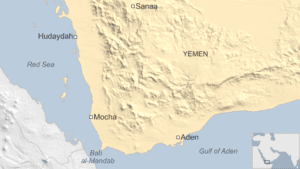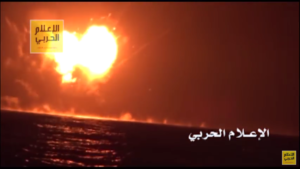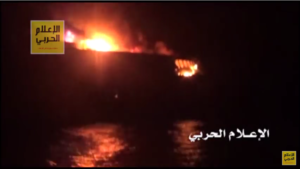Yemeni Houthi rebels on Saturday claimed they successfully fired anti-ship rockets at an United Arab Emirates military vessel in the Bab el Mandeb Strait that was approaching the Yemeni port of Mocha. The Iranian-backed Houthis posted videos of the attack which were circulated by the Lebanese Hezbollah media outlet Al Alam.
U.S. officials told Fox News on October 3 that Iran had supplied the Houthis with the “shoulder-fired rockets” that nearly destroyed the vessel, but this claim is inconsistent with footage from the video and the damage to the vessel, according to military experts who spoke with the Long War Journal. Reports indicate that it was likely a C-801 or C-802 anti-ship missile.

Map of the Bab el Mandeb Strait and Mocha port. Credit: BBC.
Bab el Mandeb is a strategic maritime chokepoint that connects the Indian Ocean to the Mediterranean through the Gulf of Aden and the Red Sea. More than 4.7 million barrels of oil flowed through this waterway daily in 2014.
The UAE is part of a Saudi-led coalition that intervened in Yemen in March 2015 to put down the Houthi insurgents who had seized control of the capital Sanaa in 2014, and to restore the exiled president Abd Rabbuh Mansur Hadi. Al Qaeda in the Arabian Peninsula (AQAP) also controls swaths of territory in central and southern Yemen, and the U.S. frequently targets AQAP with the approval of the exiled government. The United Nations has declared a humanitarian crisis in Yemen, with over 10,000 killed, at least 3,800 civilians, in the 18 months between March 2015 and August 2016.
On October 5, the UAE Foreign Ministry announced that the vessel struck on Saturday was a civilian catamaran carrying aid passing through the strait. No one was killed, but some members of the civilian crew were injured. The UAE denounced the incident as an act of terrorism, and warned about the attack’s implications for freedom of navigation. The United Nations Security Council has also condemned the attack, declaring the same day that it takes threats to shipping around Bab el Mandeb “extremely seriously.”
The United States has furthermore reiterated its commitment to upholding freedom of navigation through Bab el Mandeb, according to a strongly-worded condemnation issued by the State Department Spokesman on October 4, one day after the Houthi attack.
The U.S. Navy has dispatched to the strait two destroyers, the USS Mason and USS Nitze, and the USS Ponce – the last of these a floating staging ship which includes a compliment of special operations forces.
“Sending the warships to the area is a message that the primary goal of the Navy is to ensure that shipping continues unimpeded in the strait and the vicinity,” said a U.S. defense official.
Iran’s Islamic Revolutionary Guard Corps (IRGC), which is in charge of Tehran’s extraterritorial military activities, is believed to be arming the Houthis with missiles and rockets, including a variant of the Zelzal-3 artillery rocket that was unveiled in August and stationed near the Saudi border.
Since the summer of 2015, Western navies have intercepted at least four weapons shipments of Iranian origin bound for Yemen. In April, the U.S. Navy publicized the interception of an Iranian cargo ship seized in late March.
While visiting Saudi Arabia in late August, Secretary of State John Kerry said he was “deeply troubled” about Iranian-supplied projectiles positioned on the Saudi border. Kerry also called Iran’s “shipment of missiles and other sophisticated weapons into Yemen” as “not just a threat to Saudi Arabia; it is a threat to the region, [and] it is a threat to the United States.”


https://www.youtube.com/watch?v=c8NgDcFF_h8
[Update: Military experts told The Long War Journal on October 6 that the Houthis fired a cruise missile]
[Update: The latest data on daily oil flow through the Bab el Mandeb Strait is from 2014, not 2013 as initially stated.]
Are you a dedicated reader of FDD's Long War Journal? Has our research benefitted you or your team over the years? Support our independent reporting and analysis today by considering a one-time or monthly donation. Thanks for reading! You can make a tax-deductible donation here.








1 Comment
“U.S. officials told Fox News on October 3 that Iran had supplied the Houthis with the “shoulder-fired rockets” that nearly destroyed the vessel.”
These officials must be retards because I am pretty dam sure there is not a “shoulder fired” missile capable of, or used as a anti-ship missile unless we are talking about small craft. From all I have seen it was a version of Iranian copy of the chinese c802. The artillery rocket is interesting maybe with the right guidance accuracy/ability to hit moving targets which I would question being in Irans abilities. If it was a artillery type missile strike I would guess not a single missile but a volley to compensate accuracy.